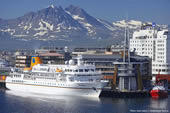DAY ONE All Aboard!
29.30.2008 Tromsø is beautiful: blue sky, sun, snow-covered mountains. The G.O Sars is docked and loading up for a three week exploration 30 hours north of Tromsø into the Atlantic. Scientists on the cruise come from Denmark, Norway, Portugal, France, Switzerland, and the United States. They are geologists, biologists, and chemists, and are focused on accomplishing a variety of experiments on this trip.
Hovedinnhold
text and photos by Courtney Flanagan
Learn more about Tromsø.
Just as I arrived with the videographer, Stein Hitland, and Elinor Bartle, in charge of public outreach, the Bathysaurus, essentially an underwater vehicle capable of taking photographs and samples from deep in the ocean, was being hauled into the wide-open side door of the ship. This equipment comes with a huge steel container, the type one might see on the back of a ten-wheeler, which serves as the control room. The entire package, shipped to the boat from Bergen, evidently initially went the wrong way, and was headed to Oslo before the mistake was discovered. It made it to Tromsø today ... good news ... but ...bad news... when the operator opened the door of the control room container, he discovered that some of the electric panels had fallen off the wall during the trucking.
Solving such problems however is part of daily life on a major expedition of this size. Last year for example the huge cable used to lower the ROV into the ocean became tangled. The crew managed to fix it within a few hours. Crew and scientists put a great deal of time and skill into solving problems as quickly as possible so that the goals of the expedition can be met.
And what are the goals of this expedition?
Here is a short explanation:
1. The scientists are looking for new hydrothermal vents, the most northerly in the world. They will be looking at depths of 3000 meters.
25% of the ocean actually seeps into the surface of the earth beneath the sea. Where it comes out again is called a hydrothermal vent. Going down below the surface closer to the center of the earth heats up the water, causing various chemical changes. Unlike such vents in the Pacific, which are sometimes as hot as 400 degrees, the Atlantic vents heat the water to a somewhat cooler temperature, cool enough to support certain forms of life. Scientists believe that the conditions near these vents may duplicate the environment that gave birth to life on earth, and might give clues to the existence of life on other planets.
2. Scientists are continuing to map and study the geology of the Mid-Atlantic Ridge. It seems to be asymmetric in our study area. On the west side of the Ridge the sea floor is pushed up to form Seamounts which have been found to have larger concentrations of life.
3. A Gravity Corer will be dropped into the earth's sea floor. It will pick up about five meters of sediment, which will not only give clues as to the geological history of the ridge, but will allow scientists to study life beneath the earth's surface.
The biomass under the earth is believed to be larger than the biomass on top of the earth's surface - elephants included!
